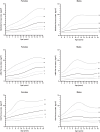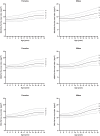Reference values for body composition in healthy urban Mexican children and adolescents
- PMID: 37845421
- PMCID: PMC11537948
- DOI: 10.1038/s41430-023-01352-1
Reference values for body composition in healthy urban Mexican children and adolescents
Abstract
Introduction: Given the increasing incidence of chronic degenerative diseases related to changes in tissues, the availability of diagnostic tools with greater accuracy in the estimation of body composition (BC) has become necessary. Interpreting the BC values of individuals requires reference data obtained from a healthy population with the same ethnicity, to identify individuals at risk for the development of negative health outcomes.
Objective: Generate reference values (RV) of body composition (BC) for Mexican children and adolescents.
Methods: This was an urban-population-based cross-sectional study of healthy Mexican children and adolescents. BC estimations by anthropometry, multifrequency bioimpedance analysis (MF-BIA) and dual-energy X-ray absorptiometry (DXA) where used to create sex- and age-specific RV by means of generalized additive models for location, scale and shape (GAMLSS).
Results: We assessed 2104 subjects, and after confirming a clinically and metabolically healthy status, we measured 1659 subjects aged 5-20 years, [806 females (49%) and 853 males (51%)] by anthropometry, MF-BIA and DXA to create sex- and age- smoothed reference centiles, lambda (L), mu (M), and sigma (S) values. We also built sex- and age-smoothed graphic curves for each variable of interest.
Conclusions: We present valid RV and curves for BC variables estimated by anthropometry, MF-BIA and DXA from clinically and metabolically healthy urban Mexican children and adolescents. These RV are different from those reported for other populations, and therefore, should be used for clinical and research purposes involving urban Mexican children and adolescents.
© 2023. The Author(s).
Conflict of interest statement
The authors declare no competing interests.
Figures



References
-
- Keys A, Fidanza F, Karvonen MJ, Kimura N, Taylor HL. Indices of relative weight and obesity. Int J Epidemiol. 2014;43:655–65. 10.1093/ije/dyu058 - PubMed
-
- Wells JC. A Hattori chart analysis of body mass index in infants and children. Int J Obes Relat Metab Disord. 2000;24:325–9. 10.1038/sj.ijo.0801132. - PubMed
-
- Toomey CM, Cremona A, Hughes K, Norton C, Jakeman P. A Review of Body Composition Measurement in the Assessment of Health. Top Clin Nutr. 2015;30:16–32. 10.1097/TIN.0000000000000017
MeSH terms
LinkOut - more resources
Full Text Sources
Research Materials

